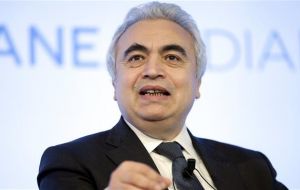MercoPress. South Atlantic News Agency
Today's stunted oil prices could cause oil price shock in 2020
 Eurasia Group forecasts about 7 million barrels per day (MMbbl/d) of new crude supply by 2022.
Eurasia Group forecasts about 7 million barrels per day (MMbbl/d) of new crude supply by 2022.  IEA's Executive Director Fatih Birol said no major oil projects were started in 2016 and there were zero large oil discoveries because there is no money for exploration
IEA's Executive Director Fatih Birol said no major oil projects were started in 2016 and there were zero large oil discoveries because there is no money for exploration As oil prices remain unsteady and OPEC continues to make headlines every hour, the world is focused on oil's immediate future. As Saudi Arabia announces plans to slash production and move their economy away from oil dependency, many industry insiders are predicting that the now over-saturated market will reach an equilibrium with higher commodity prices by 2018 and U.S. shale production will continue to grow along with global demand.
Robert Johnston, the CEO of one of the world's biggest political risk consultancies, is unconvinced. In a speech made at the Association of International Petroleum Negotiators' 2017 International Petroleum Summit, Johnston laid out his concerns for the future of oil.
“What I don't hear people asking is, ‘then what?' Are the Saudis going to maintain these production cuts forever, or at some point do they have to start reversing that? I think in 2018 they will be reversing those production cuts,” he said. These important questions aren't getting enough attention according to Johnston, whose firm Eurasia Group foresees a fast-approaching supply gap that Saudi Arabia and U.S. oil may not be able to fill.
Eurasia Group forecasts about 7 million barrels per day (MMbbl/d) of new crude supply by 2022. This includes about 5 MMbbl/d of U.S. shale growth and about 2 MMbbl/d from oil sands and deepwater extraction. But by the year 2022 , another 15 MMbbl/d of new supply may be needed, as demand trends predict an annual growth rate of about 1 MMbbl/d. With this kind of impending discrepancy between supply and demand, the industry needs to start looking for new sources of oil, and quickly.
Despite the recent dip in oil prices, industry experts have been predicting a supply-gap and rising oil prices for years. This is due in large part to an oil investment drought marked by two year of consecutive decline, a statistic that has no precedent in the oil industry. This year a report by the International Energy Agency concluded that if oil investment remains stagnant over the next few years, by 2020 we will see a significant increase in the price of oil as global demand continues to climb.
The IEA's Executive Director Fatih Birol addressed these findings in a keynote address at the Atlantic Council Global Energy Forum in Abu Dhabi in January, announcing that no major oil projects were started in the last year and there were zero large oil discoveries “because there is no money for exploration. You find something if you look for it,” Birol said.
The potential supply gap has far-reaching implications that we are not ready to combat. Gas and oil are still fundamental to much of the world's infrastructure, despite a steady increase of research and utilization of renewable energy resources. While electric cars continue to show a promising future, especially in the light of ambitious new green car policy initiatives in India and China, they still account for less than 2% of the world's cars. And, as the global middle class continues to grow and exercise their buying power, the demand for oil will continue to grow alongside them.
The oil industry desperately needs new sources of oil, and they need new investors and technologies to find those sources quickly. There are currently a wide variety of techniques employed to find new deposits (seismic prospecting, well logging, gravity surveying, magnetic prospecting, and geochemical prospecting, etc.) but these are all methods with significant limitations in their ability to accurately estimate the size of new oil and gas deposits.
Many companies, including oil giant BP, have begun efforts to develop of artificial intelligence programs with algorithms that will allow them to find and drill with unprecedented accuracy in the future, but the technology is not yet ready. We can only hope that it will be ready by 2020 or that the IEA is wrong in their predictions.
By Haley Zaremba for Oilprice.com




Top Comments
Disclaimer & comment rules-

-

Read all comments“As Saudi Arabia announces plans to slash production and move their economy away from oil dependency....”
May 25th, 2017 - 07:56 pm 0This is the sort of oft-repeated but non-occurring event that reminds us of Argentina's bi-weekly government press report that it is going to buy new fighter aircraft and slash inflation to less than 4 percent annually.
The good news is that the Falkland Islands will be delighted to help fill the supply gap in another few years.
May 27th, 2017 - 08:30 pm 0Commenting for this story is now closed.
If you have a Facebook account, become a fan and comment on our Facebook Page!